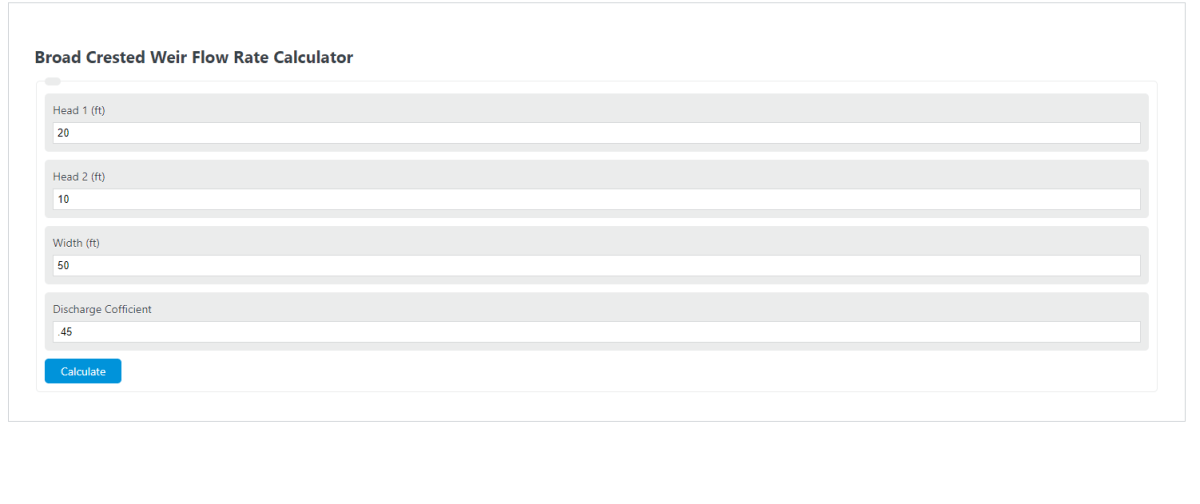Enter head 1 and head 2 on the weir, the width of the weir, and the discharge coefficient into the calculator to determine the broad crested weir flow rate.
Broad Crested Weir Formula
The following equation is used to calculate the Broad Crested Weir flow rate.
Q = D * h2* b * SQRT ( 2*g* (h1-h2) )
- Where Q is the flow rate ft^3/s
- D is the discharge coefficient
- h2 is the head from mid-weir to the bottom of the weir (ft)
- b is the width of the weir (ft)
- h1 is the head from the top to mid-weir (ft)
- g is the acceleration due to gravity (ft/s^2)
What is a Broad Crested Weir?
A broad-crested weir is a hydraulic structure commonly used in civil engineering and water management to control water flow in rivers, canals, and reservoirs.
Broad-crested weirs are crucial for regulating water levels, ensuring a controlled and stable water flow downstream.
By adjusting the height of the weir crest, engineers can manage the quantity of water passing through the structure. This control helps prevent both excessive flooding and inadequate water supply, protecting communities and ecosystems alike.
How to Calculate Broad Crested Weir discharge rate?
Example Problem:
The following example outlines the steps and information needed to calculate the discharge rate of a Broad Crested Weir.
First, determine the discharge coefficient. In this example, the discharge coefficient is .45.
Next, determine the head from the top to mid-weir. This is measured to be 20 ft.
Next, determine the head from mid-weir to the bottom of the weir. This is found to be 10 ft.
Next, determine the width of the weir. In this case, this 50 ft.
Finally, calculate the discharge rate using the formula above:
Q = D * h2* b * SQRT ( 2*g* (h1-h2) )
Q = .45 * 10* 50 * SQRT ( 2*32.174* (20-10) )
Q = 5707.552 ft^3/s
FAQ
What is the discharge coefficient in a Broad Crested Weir calculation?
The discharge coefficient is a dimensionless number that accounts for the flow over the weir’s crest’s efficiency. It varies based on the weir’s shape, size, and flow conditions. In calculations, it’s used to adjust the theoretical flow rate to match the actual flow rate observed.
How does the height of the weir affect the flow rate?
The height of the weir, particularly the difference in height between the top to mid-weir (h1) and mid-weir to bottom (h2), directly influences the flow rate. A greater height difference results in a higher potential energy difference, which, according to the formula, increases the flow rate. Adjusting the weir’s height allows for control over the volume of water passing over it.
Why is it important to control water flow in rivers, canals, and reservoirs?
Controlling water flow is crucial for preventing flooding, ensuring adequate water supply, and maintaining ecological balance. By managing the flow rate, broad-crested weirs help protect communities from water-related hazards, support agriculture by regulating irrigation, and preserve aquatic ecosystems by maintaining stable water levels.
